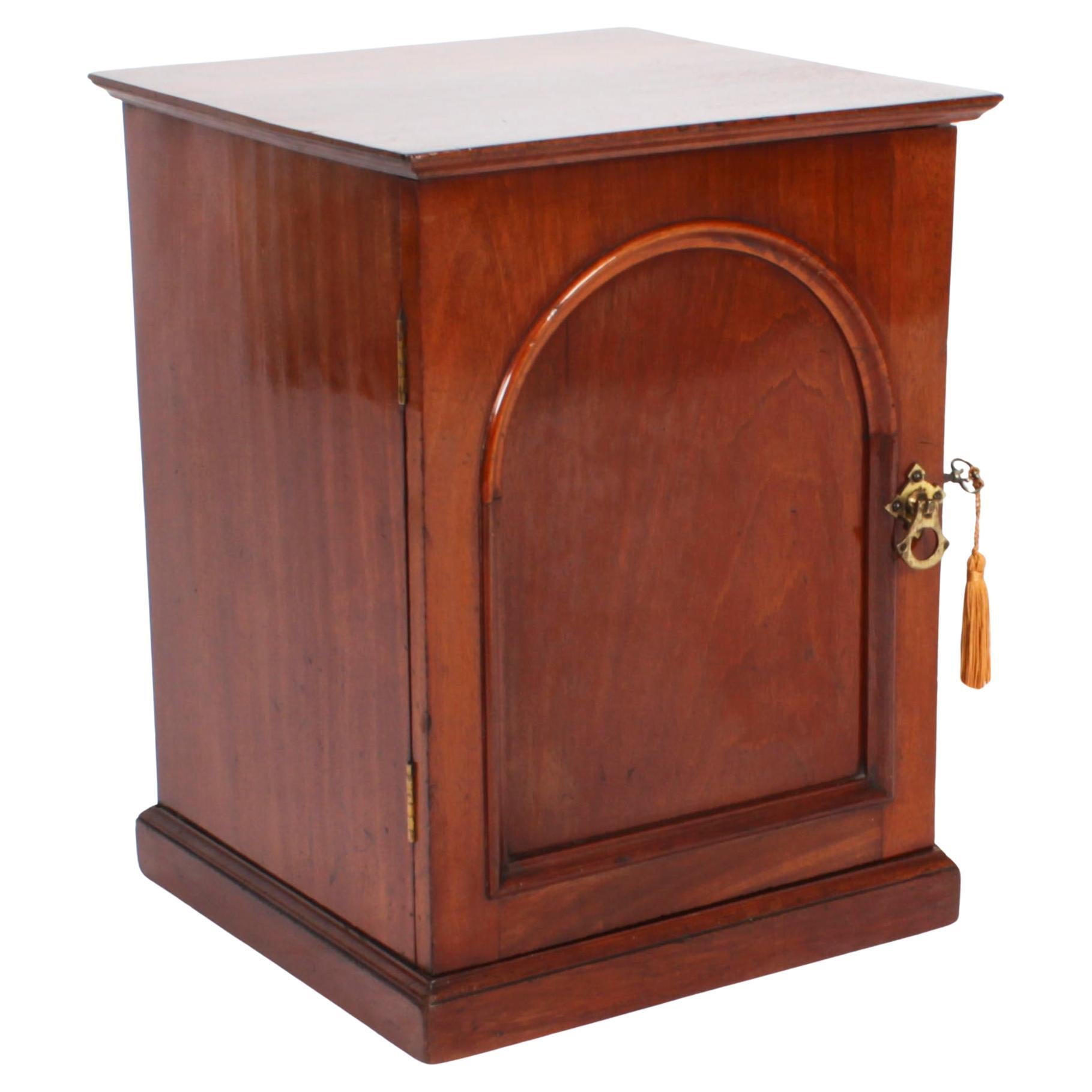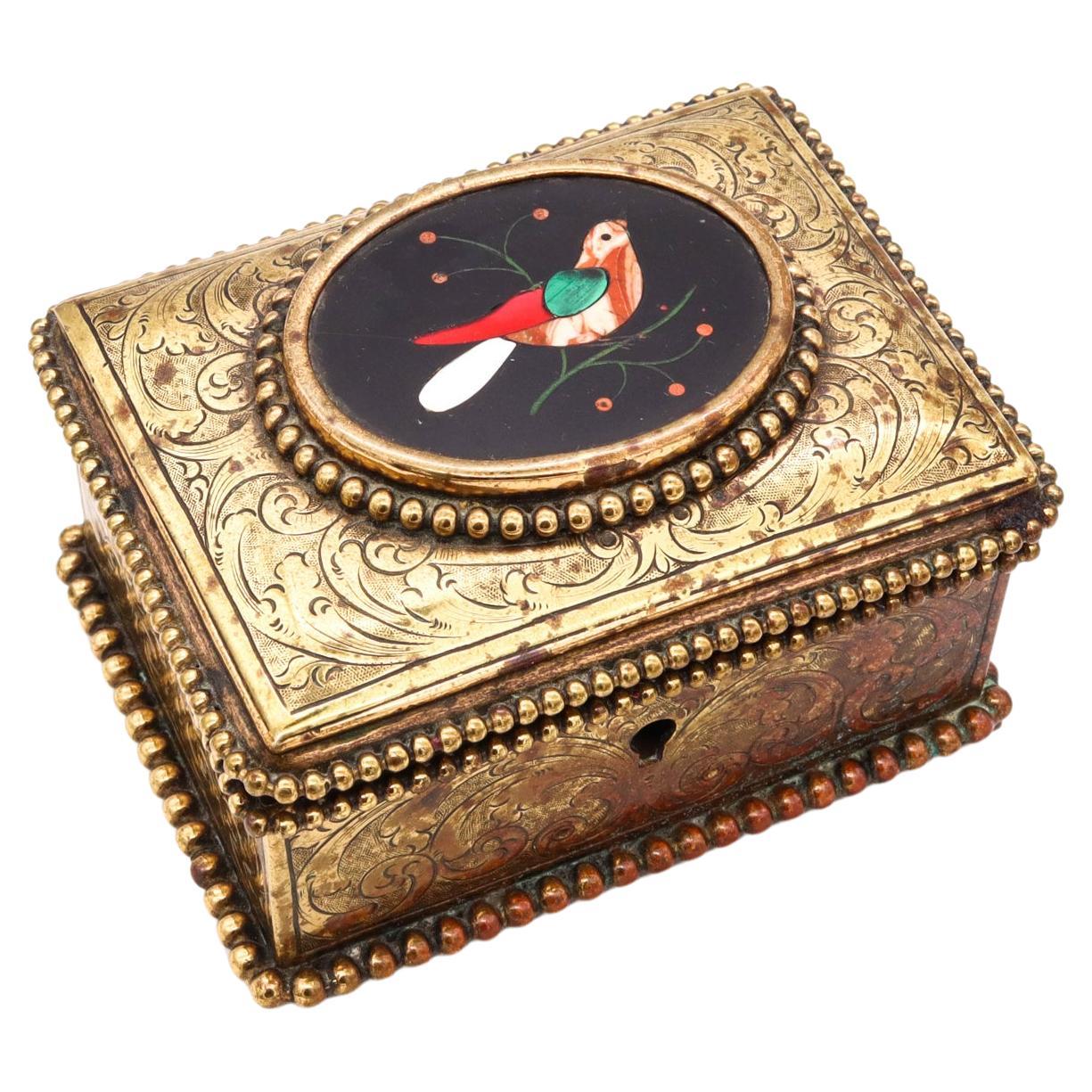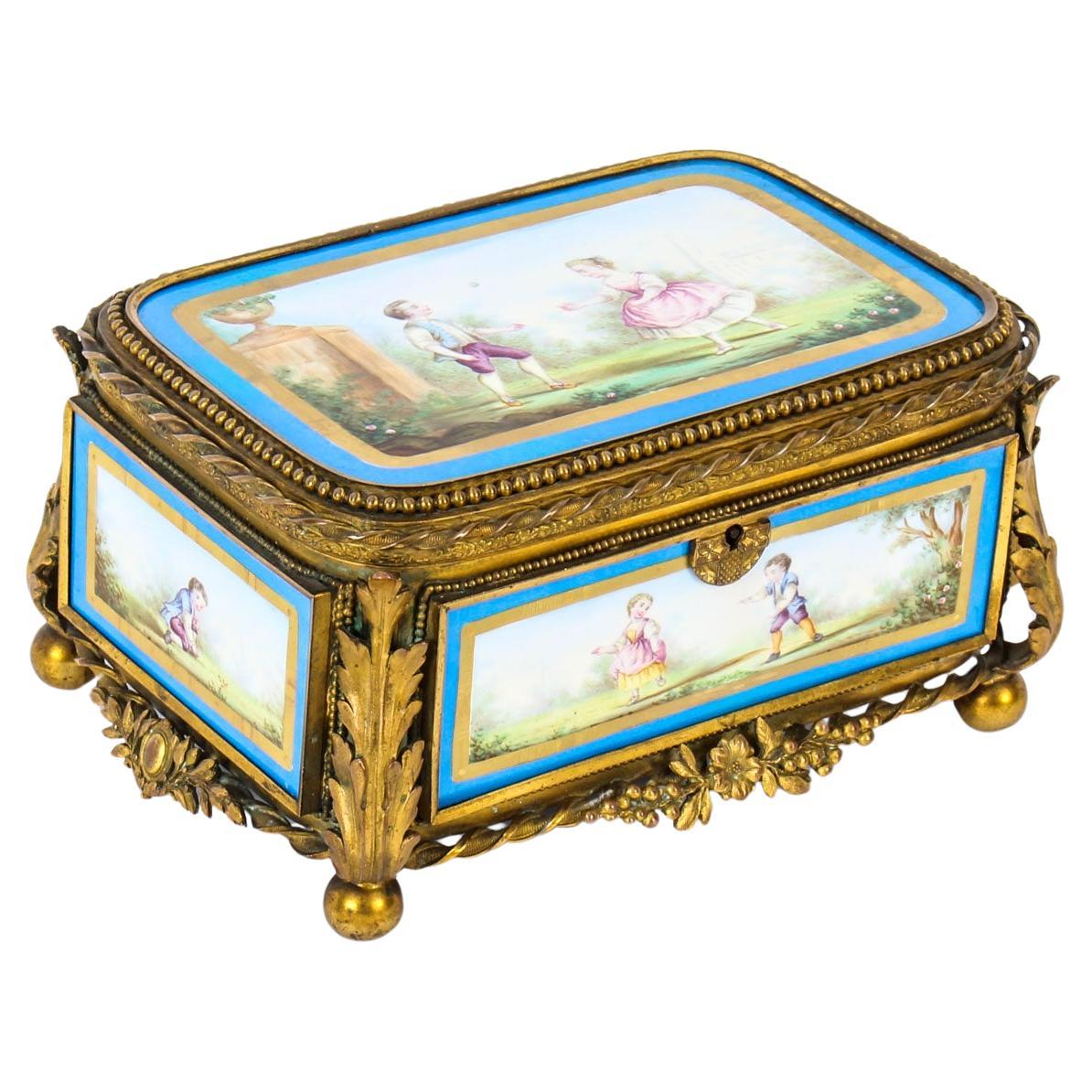Items Similar to Antique Ormolu Mounted Pietra Dura Jewellery Cabinet 19th C
Want more images or videos?
Request additional images or videos from the seller
1 of 21
Antique Ormolu Mounted Pietra Dura Jewellery Cabinet 19th C
About the Item
This is an absolutely fabulous antique French engraved ormolu and Pietra Dura mounted jewellery cabinet, Circa 1860 in date.
The casket is in the form of a cabinet, with three fitted jewellery compartments on the top, the central compartment is superbly inset with an ornate oval inset pietra dura mount, with a lidded compartment to each side.
The bow-sided breakfront design with figural supports, with side doors each enclosing a blue glass perfume bottle with a pietra dura lid, and hinged doors fitted with further exquisite pietra dura panels that open to reveal two small drawers, the interior compartmnts of the cabinet have all been relined in grey silk.
This item is of superb quality with fabulous engraved decoration, is extremely rare and will instantly enhance any desktop.
Condition:
In excellent condition having been cleaned polished and relined in our workshops, with no dings, dents or signs of repair. Please see photos for confirmation.
Dimensions in cm:
Height 22 cm x Width 22 cm x Depth 13 cm
Dimensions in inches:
Height 9 inches x Width 9 inches x Depth 5 inches
Pietra dura is a term for the inlay technique of using cut and fitted, highly polished coloured stones to create images. It is considered a decorative art.
Pietre dure is an Italian plural meaning "hard rocks" or hardstones; the singular pietra dura is also encountered in Italian. In Italian, but not in English, the term embraces all gem engraving and hardstone carving, which is the artistic carving of three-dimensional objects in semi-precious stone, normally from a single piece, for example in Chinese jade. The traditional convention in English has been to use the singular pietra dura just to denote multi-colored inlay work. However, in recent years there has been a trend to use pietre dure as a term for the same thing, but not for all of the techniques it covers, in Italian.
But the title of a 2008 exhibition at the Metropolitan Museum of Art, New York, Art of the Royal Court: Treasures in Pietre Dure from the Palaces of Europe used the full Italian sense of the term, probably because they thought that it had greater brand recognition. The material on the website speaks of objects such as a vase in lapis lazuli as being examples of "hardstone carving (pietre dure)"
The Victoria & Albert Museum in London uses both versions on its website, but uses pietra dura. "A method of inlaying coloured marbles or semi-precious stones into a stone base, often in geometric or flower patterns...."
Giovanni Montelatici (1864-1930) was an Italian Florentine artist whose brilliant work has been distributed across the world by tourists and collectors. Owners of Giovanni's work included Donald Trump.
Ormolu - (from French 'or moulu', signifying ground or pounded gold) is an 18th-century English term for applying finely ground, high-carat gold in a mercury amalgam to an object of bronze.The mercury is driven off in a kiln leaving behind a gold-coloured veneer known as 'gilt bronze'.
The manufacture of true ormolu employs a process known as mercury-gilding or fire-gilding, in which a solution of nitrate of mercury is applied to a piece of copper, brass, or bronze, followed by the application of an amalgam of gold and mercury. The item was then exposed to extreme heat until the mercury burned off and the gold remained, adhered to the metal object.
After around 1830 because legislation had outlawed the use of mercury other techniques were used instead. Electroplating is the most common modern technique. Ormolu techniques are essentially the same as those used on silver, to produce silver-gilt..
Our reference: A2707a
- Dimensions:Height: 8.67 in (22 cm)Width: 8.67 in (22 cm)Depth: 5.12 in (13 cm)
- Materials and Techniques:
- Place of Origin:
- Period:
- Date of Manufacture:Circa 1860
- Condition:
- Seller Location:London, GB
- Reference Number:
About the Seller
5.0
Platinum Seller
These expertly vetted sellers are 1stDibs' most experienced sellers and are rated highest by our customers.
Established in 1983
1stDibs seller since 2012
1,198 sales on 1stDibs
Typical response time: 1 hour
Associations
LAPADA - The Association of Arts & Antiques Dealers
- ShippingRetrieving quote...Ships From: London, United Kingdom
- Return PolicyA return for this item may be initiated within 14 days of delivery.
More From This SellerView All
- Antique Victorian Table Top Jewellery Collectors Cabinet 19th CLocated in London, GBThis is a elegant Victorian mahogany table top jewellery collectors cabinet, circa 1840 in date. The cabinet is freestanding, finished all...Category
Antique 1840s English Victorian Jewelry Boxes
MaterialsMahogany
- Antique French Sevres Porcelain and Ormolu Jewellery Casket 19th CenturyLocated in London, GBThis is a fabulous antique French Ormolu and Sevres Porcelain jewellery casket, circa 1860 in date. This magnificent casket is rectangular in shape with the top and each side except...Category
Antique 1860s Jewelry Boxes
MaterialsOrmolu
- Antique Ormolu & Agate Mounted Casket by Asprey, 19th CenturyLocated in London, GBThis is a superb antique gilt bronze and agate mounted casket by Asprey, Circa 1870 in date. The casket features a rectangular outline with domed lid which opens to reveal two clear glass scent bottles. It is stamped Charles Asprey, 166 Bond Street, Provenance: Lady Elizabeth Prinfle Lady in waiting to Queen Victoria, lived at Bonchurch, Isle of Wight It is a lovely piece which will make an unforgettable gift. Condition: In excellent condition having been beautifully cleaned in our workshops, please see photos for confirmation. Dimensions in cm: height 10.5 x width 12.5 x depth 7.5 Dimensions in inches: height 4 inches x width 5 inches x depth 3 inches Asprey was established in England in 1781 and founded as a silk printing business by William Asprey, it soon became a luxury emporium. In 1841, William Asprey's elder son Charles went into partnership with a stationer located on London's Bond Street. In 1847 the family broke with this partner and moved into 167 New Bond Street, the premises Asprey occupies today. From its central London location Asprey advertised 'articles of exclusive design and high quality, whether for personal adornment or personal accompaniment and to endow with richness and beauty the table and homes of people of refinement and discernment.' An early speciality was dressing cases. Asprey crafted traditional cases and designs, mostly in leather, suitable for the new style of travel ushered in by railways. The main competitors at the time were H.J. Cave & Sons. Asprey was recognised for its expertise when it won a gold medal for its dressing cases at the International Exhibition of 1862 but lost out to its rivals, H.J. Cave & Sons in 1867. The company consolidated its position through acquisitions. In 1859 Asprey absorbed Edwards, an award winning maker of dressing cases and holder of a Royal Warrant. The company also purchased the Alfred Club at 22 Albemarle Street, which backed on to the New Bond Street store and meant that Asprey now had entrances on two of London's most fashionable streets. In 1862, Asprey was granted a Royal Warrant by Queen Victoria. The Prince of Wales, later to be crowned Edward VII, granted another Royal Warrant. In 1953, for the coronation of Elizabeth II, Asprey paid homage with the Asprey Coronation Year Gold Collection, which featured a dessert, coffee and liqueur service in 18-carat gold and weighed almost 27 pounds. In April 1953, it went on show in the New Bond Street store and subsequently toured the United States. As the business grew, the company acquired manufacturing facilities and hired silversmiths, goldsmiths, jewellers and watchmakers including Ernest Betjeman, the father of the distinguished poet John Betjeman, one of the most highly regarded craftsman and designers of his day. In the twenties, commissions poured in from around the world, from American millionaire J. Pierpont Morgan to potentates such as the Maharaja of Patiala, who commissioned a huge teak travelling trunk for each of his wives in which each trunk was fitted with solid silver washing and bathing utensils with waterspouts of ornate tiger head and lined with blue velvet. Asprey cigarette cases became collectable amongst young sophisticates who delighted in its other modern products, including travel clocks, safety razors and automatic pencil sharpeners. Asprey Jewellery Asprey has a tradition of producing jewellery inspired by the blooms found in English gardens. Over the decades jewelled interpretations of flowers have evolved to include the Crown Daisy, Rose, Calla Lily and Lily Pad collections. The master diamond cutter Gabi Tolkowsky created the Asprey cut. The cushion cut gave Tolkowsky options for incorporating the Asprey "A" inscription around the edges of the stone. The result was the 61-facet Asprey cut, maximising light refraction to brilliant effect. The shape of the Asprey cut means that the cutting process can be done only by hand, unlike many other stones that involve machine cutting. Asprey Leather - the women's collection of clutches and handbags, such as those featured in the 1781 collection, come from crocodile, python and ostrich. The men's collection includes wallets, cardholders and travel watch cases crafted from lido, calf or alligator. Other items include the briefcases and backgammon boards. Asprey Silver - offers classic and whimsical contemporary silver pieces – such as the saltcellar fashioned to look like a cement mixer...Category
Antique 1870s English Decorative Boxes
MaterialsAgate, Ormolu
- Antique French Ormolu Bevelled Glass Bijouterie Table Top Display Cabinet 19th CLocated in London, GBThis is an elegant antique French ormolu and bevelled glass table top bijouterie cabinet, circa 1880 in date. It is of Neo-Grec style and of rectangular form with hipped top and ...Category
Antique 1880s French Jewelry Boxes
MaterialsOrmolu
- Antique Victorian Sterling Silver Jewellery Box Casket H. Matthews 19th CLocated in London, GBThis is a lovely antique Victorian sterling silver jewellery casket / pin cushion bearing the makers mark of H.Matthews, and hallmarks for Birmingham 1899. The hinged lid is fitt...Category
Antique 1890s English Victorian Jewelry Boxes
MaterialsSterling Silver
- Antique French Silvered Copper Jewellery Casket Box B Wicker 19th CLocated in London, GBThis is a beautiful Antique silvered copper French Jewellery Casket, engraved by by the famous French engraver B.Wicker, Paris C 1880's. This...Category
Antique 1880s French Jewelry Boxes
MaterialsCopper
You May Also Like
- Stunning 19th Century Kingwood Jewellery Box with Ormolu MountsLocated in Dublin, IEA stunning 19th century kingwood jewellery box with gorgeous ormolu dec-oration throughout, the moulded top of rectangular form beautifully quar-tered veneered and cross banded with ...Category
Antique 19th Century French Jewelry Boxes
MaterialsOrmolu
- Italian 19th Century Antique Pietra Dura Mosaic Chest Box in Gilt BronzeLocated in Miami, FLA Pietra Dura brass box. Beautiful antique little box, created probably in Napoles, Italy as a treasure chest, circa 1880s. It was crafted in solid gilded brass with nice Baroque ...Category
Antique Late 19th Century Italian Renaissance Revival Decorative Boxes
MaterialsMulti-gemstone, Brass
- 19th Century French onyx + ormolu jewellery casket.Located in Brighton, SussexA very good quality French 19th Century onyx, ormolu mounted jewellery casket, having Pietra dura floral plaques to each corner, set into classically shaped gilded ormolu mounts. Ba...Category
Antique Late 19th Century French Jewelry Boxes
MaterialsOnyx, Ormolu
- Late 19th Century Italian Box with Pietra Dura Panelled TopLocated in Chapel Hill, NCLate 19th century Italian box with pietra dura panelled top. The box of ebony & mahogany (small loss to underside of bottom). Fine pietra dura floral spray. Three faint hairlines in ...Category
Antique Late 19th Century Italian Decorative Boxes
MaterialsWood
- Very Large 19th Century Italian Walnut Chest with Pietra Dura PlaquesLocated in New York, NYVery large and impressive 19th century Italian Walnut Chest with Pietra Dura Plaques. The plaques are possibly earlier than the box.Category
Antique Late 19th Century Italian Decorative Boxes
MaterialsStone
- Italian 19th Century Florentine St. Ebony and Pietra Dura Marble BoxLocated in West Palm Beach, FLA beautiful and most elegant Italian 19th century Florentine st. Ebony and Pietra Dura marble box. The box is raised by fine bun feet below the straight base with a lovely wrap aroun...Category
Antique 19th Century Italian Decorative Boxes
MaterialsMarble





